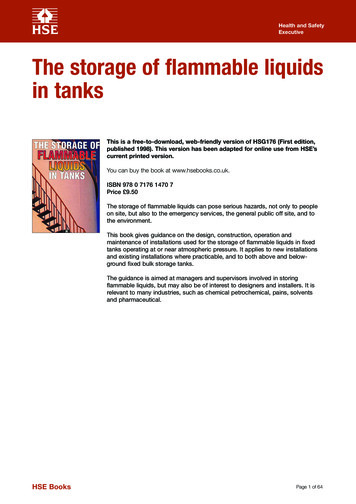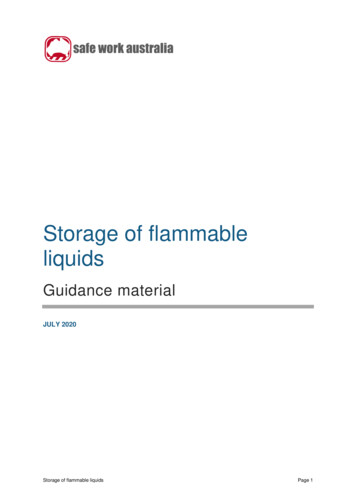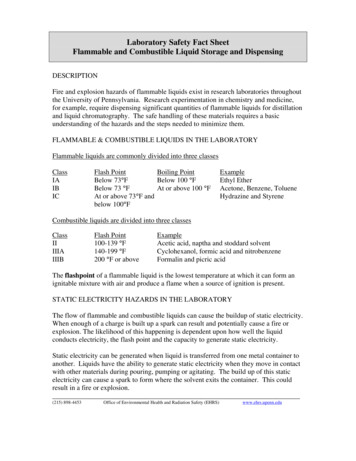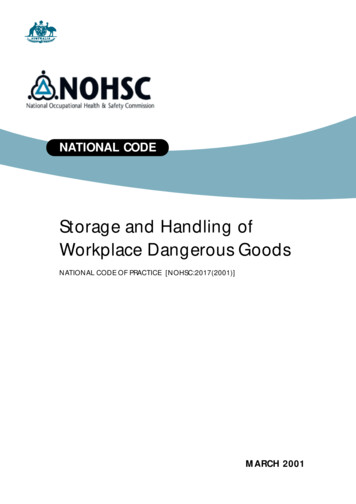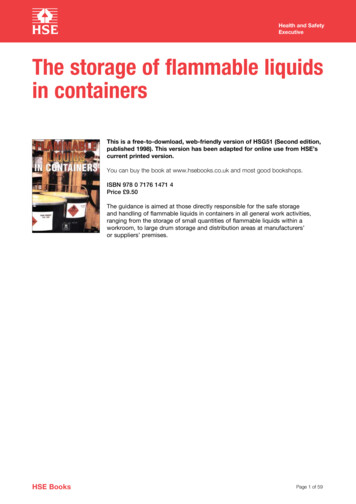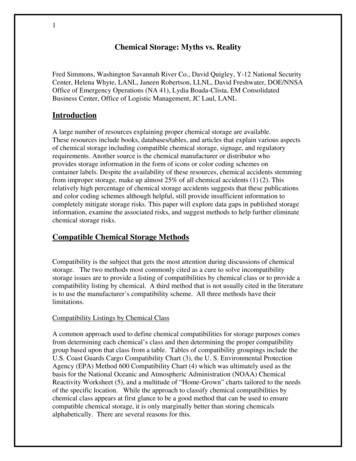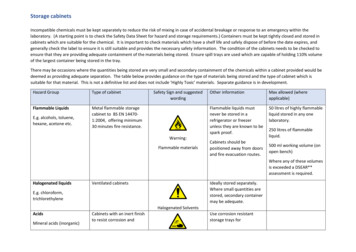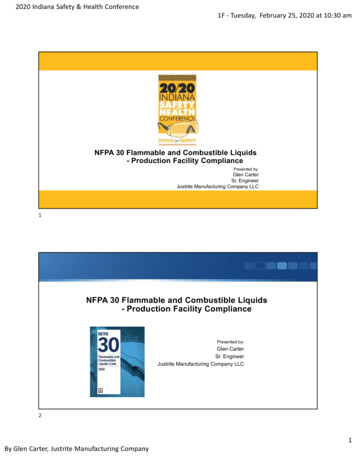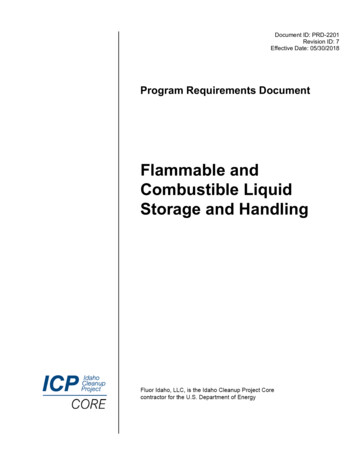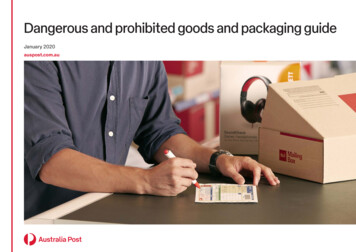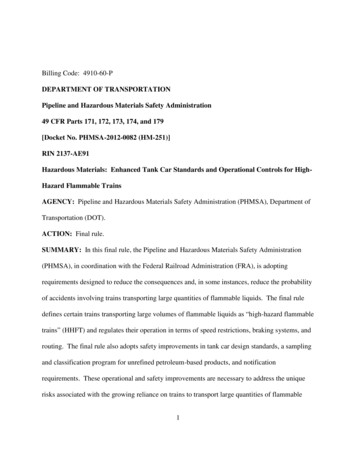
Transcription
Billing Code: 4910-60-PDEPARTMENT OF TRANSPORTATIONPipeline and Hazardous Materials Safety Administration49 CFR Parts 171, 172, 173, 174, and 179[Docket No. PHMSA-2012-0082 (HM-251)]RIN 2137-AE91Hazardous Materials: Enhanced Tank Car Standards and Operational Controls for HighHazard Flammable TrainsAGENCY: Pipeline and Hazardous Materials Safety Administration (PHMSA), Department ofTransportation (DOT).ACTION: Final rule.SUMMARY: In this final rule, the Pipeline and Hazardous Materials Safety Administration(PHMSA), in coordination with the Federal Railroad Administration (FRA), is adoptingrequirements designed to reduce the consequences and, in some instances, reduce the probabilityof accidents involving trains transporting large quantities of flammable liquids. The final ruledefines certain trains transporting large volumes of flammable liquids as “high-hazard flammabletrains” (HHFT) and regulates their operation in terms of speed restrictions, braking systems, androuting. The final rule also adopts safety improvements in tank car design standards, a samplingand classification program for unrefined petroleum-based products, and notificationrequirements. These operational and safety improvements are necessary to address the uniquerisks associated with the growing reliance on trains to transport large quantities of flammable1
liquids. They incorporate recommendations from the National Transportation Safety Board(NTSB) and from the public comments, and are supported by a robust economic impact analysis.DATES: Effective date: This final rule is effective [INSERT DATE 60 DAYS AFTER DATEOF PUBLICATION IN THE FEDERAL REGISTER].Incorporation by reference date: The incorporation by reference of the publication listed in thisrule is approved by the Director of the Federal Register as of [INSERT DATE 60 DAYS AFTERDATE OF PUBLICATION IN THE FEDERAL REGISTER].ADDRESSES: You may find information on this rulemaking (Docket No. PHMSA-2012-0082)at Federal eRulmaking Portal: http://www.regulations.gov.FOR FURTHER INFORMATION CONTACT: Rob Benedict and Ben Supko, (202) 3668553, Standards and Rulemaking Division, Pipeline and Hazardous Materials SafetyAdministration or Karl Alexy, (202) 493-6245, Office of Safety Assurance and Compliance,Federal Railroad Administration, 1200 New Jersey Ave., SE., Washington, DC 20590.SUPPLEMENTARY INFORMATION:Table of Contents of Supplementary InformationI. Executive SummaryII. Background and Approach to Rail SafetyA. BrakingB. Speed RestrictionsC. Track Integrity, Securement, Engineer and Conductor Certification, Crew Sizeand the Safety of Freight Railroad OperationsD. RoutingE. NotificationF. Oil Spill Response PlanningG. ClassificationH. Packaging / Tank CarIII. Recent Regulatory Actions Addressing Rail SafetyA. Rulemaking Actions2
B. Emergency OrdersIV. Non-Regulatory Actions Addressing Rail SafetyA. Safety Alerts and AdvisoriesB. Operation ClassificationC. Call to ActionD. Stakeholder OutreachV. NTSB Safety RecommendationsVI. Incorporation by Reference Discussion Under 1 CFR Part 51VII. Summary and Discussion of Public CommentsA. Miscellaneous Relevant Comments1. Harmonization2. Definition of High-Hazard Flammable Train3. Crude Oil Treatment4. Scope of RulemakingB. Tank Car Specification1. New Tank Car Construction2. Retrofit Standard3. Performance Standard4. Implementation TimelineC. Speed RestrictionsD. Advanced Brake Signal Propagation SystemsE. ClassificationF. RoutingG. NotificationVIII. Section by Section ReviewIX. Impact of Adopted Regulation on Existing Emergency OrdersX. Regulatory Review and NoticesA. Executive Order 12866, Executive Order 13563, Executive Order 13610, andDOT Regulatory Policies and ProceduresB. Unfunded Mandates Reform ActC. Executive Order 13132D. Executive Order 13175E. Regulatory Flexibility Act, Executive Order 13272, and DOT Policies andProceduresF. Paperwork Reduction ActG. Environmental AssessmentH. Privacy ActI. Executive Order 13609 and International Trade AnalysisJ. Statutory/Legal Authority for this RulemakingK. Regulation Identifier Number (RIN)L. Executive Order 13211XI. Regulatory Text3
I.Executive SummaryThe Pipeline and Hazardous Materials Safety Administration (PHMSA), in coordinationwith the Federal Railroad Administration (FRA), is issuing this final rule, titled “HazardousMaterials: Enhanced Tank Car Standards and Operational Controls for HHFTs,” in order toincrease the safety of flammable liquid shipments by rail. The final rule is necessary due to theexpansion in United States (U.S.) energy production, which has led to significant challenges forthe country’s transportation system. PHMSA published a notice of proposed rulemaking(NPRM) on August 1, 2014. See 79 FR 45015. This final rule addresses comments to theNPRM and amends the existing hazardous materials regulations (HMR; 49 CFR parts 171-180)pertaining to tank car designs, speed restrictions, braking systems, routing, sampling andclassification, and notification requirements related to certain trains transporting large quantitiesof flammable liquids.Expansion in oil production has resulted in a large volume of crude oil being transportedto refineries and other transport-related facilities, such as transloading facilities throughout thecountry. With a growing domestic supply, rail transportation has emerged as a flexiblealternative to transportation by pipeline or vessel, which have historically delivered the vastmajority of crude oil to U.S. refineries. The volume of crude oil carried by rail increased 4234
percent between 2011 and 2012. 1,2 In 2013, the number of rail carloads of crude oil surpassed400,000. 3,4 Further, based on information provided by the Association of American Railroads(AAR), the U.S. Energy Information Administration (U.S. EIA) asserts the amount of crude oiland refined petroleum products moved by U.S. railroads continued to increase by nine percentduring the first seven months of 2014, when compared with the same period in 2013.Millions of Barrels per DayNumber of Carlaods per WeekFigure 1: Average Weekly U.S. Rail Carloads of Crude Oil and Petroleum Products1See U.S. Rail Transportation of Crude Oil: Background and Issues for e Table 9 of EIA refinery report p://www.stb.dot.gov/stb/industry/econ il.cfm?id 177515
Figure 1 visually demonstrates the considerable increase in crude oil and petroleum shipments byrail. 5U.S. ethanol production has also increased considerably during the last 10 years and hasgenerated similar growth in the transportation of ethanol by rail. 6 Ethanol constitutes 26 percentof the total number of rail hazardous materials shipments, and is 1.1 percent of all railroadshipments. 7Crude oil and ethanol comprise approximately 68 percent of the flammable liquidstransported by rail. The inherent risk of flammability of these materials is compounded in thecontext of rail transportation because petroleum crude oil and ethanol are commonly shipped inlarge quantities, either as large blocks of material in a manifest train or as a single commoditytrain (commonly referred to as a “unit train”). As detailed in the NPRM, in recent years, trainaccidents/incidents (train accidents) involving the release of a flammable liquid and resulting infires and other severe consequences have occurred. See the Regulatory Impact Analysis, postedin the docket, for a detailed description of the accidents considered for this rulemaking.Federal hazardous materials transportation law (49 U.S.C. 5101-5128) authorizes theSecretary of Transportation (Secretary) to “prescribe regulations for the safe etail.cfm?id 177516Association of American Railroads. 2013. Railroads and Ethanol. Available online .Rail.Transportation.and.Safety.pdf?nocdn 16
including security, of hazardous material in intrastate, interstate, and foreign commerce.” TheSecretary delegated this authority to PHMSA. 49 CFR § 1.97(b). PHMSA is responsible foroverseeing a hazardous materials safety program that minimizes the risks to life and propertyinherent in transportation in commerce. On a yearly basis the HMR provides safety and securityrequirements for more than 2.5 billion tons of hazardous materials (hazmat), valued at about 2.3trillion, and hazmat was moved 307 billion miles on the nation's interconnected transportationnetwork. 8 In addition, the HMR include operational requirements applicable to each mode oftransportation. The Secretary also has authority over all areas of railroad transportation safety(Federal railroad safety laws, principally 49 U.S.C. chapters 201-213), and this authority isdelegated to FRA. 49 CFR § 1.89. FRA inspects and audits railroads, tank car facilities, andhazardous material offerors for compliance with both FRA and PHMSA regulations. FRA alsohas an extensive, well-established research and development program to enhance all elements ofrailroad safety, including hazardous materials transportation. As a result of the shared role in thesafe and secure transportation of hazardous materials by rail, PHMSA and FRA work veryclosely when considering regulatory changes and the agencies take a system-wide,82012 Commodity Flow Survey, Research and Innovative Technology Administration (RITA), Bureau ofTransportation Statistics (BTS). s/jsf/pages/productview.xhtml?pid CFS 2012 00H01&prodType table7
comprehensive approach consistent with the risks posed by the bulk transport of hazardousmaterials by rail.This rulemaking is intended to reduce the likelihood of train accidents involvingflammable liquids, and mitigate the consequences of such accidents should they occur. In thisfinal rule, PHMSA is revising the HMR to establish requirements for any “high-hazardflammable train” (HHFT) that is transported over the U.S. rail network. Based on analysis of therisk of differing train compositions, this rule defines an HHFT as a train comprised of 20 or moreloaded tank cars of a Class 3 flammable liquid in a continuous block or 35 or more loaded tankcars of a Class 3 flammable liquid across the entire train. For the purposes of advanced brakingsystems, this rule also defines a “high-hazard flammable unit train” (HHFUT) as a traincomprised of 70 or more loaded tank cars containing Class 3 flammable liquids traveling speedsat greater than 30 mph. The rule ensures that the requirements are closely aligned with the risksposed by the operation of trains that are transporting large quantities of flammable liquids. Asdiscussed further in this preamble and in the accompanying RIA, this rule primarily impactstrains transporting large quantities of ethanol and crude oil, because ethanol and crude oil aremost frequently transported in high-volume shipments than when transported in a single train,and such trains would meet the definition of an HHFT. By revising the definition of HHFT fromthat which was proposed in the NPRM, we have clarified the scope of the final rule and focused8
on the highest-risk shipments, while not affecting lower-risk trains that are not transportingsimilar bulk quantities of Class 3 flammable liquids. 9PHMSA and FRA have used a variety of regulatory and non-regulatory methods toaddress the risks of the bulk transport of flammable liquids, including crude oil and ethanol, byrail. These efforts include issuing guidance, conducting rulemakings, participating in rail safetycommittees, holding public meetings, enhancing enforcement efforts, and reaching out to thepublic. All of these efforts are consistent with our system-wide approach.PHMSA and FRA focus on prevention, mitigation and response to manage and reducethe risk posed to people and the environment by the transportation of hazardous materials by rail.When addressing these issues, PHMSA and FRA focus on solutions designed to reduce theprobability of accidents occurring and to minimize the consequences of an accident should oneoccur.In this final rule, we are revising the HMR to establish requirements specific to HHFTs.As described in greater detail throughout this document, the final rule takes a system-wide,comprehensive approach consistent with the risks posed by HHFTs. Specifically, Table 19In the August 1, 2014, NPRM, an HHFT was defined as a train comprised of 20 or more carloads of a Class 3flammable liquid. This rule defines an HHFT as a train comprised of 20 or more tank car loads of a Class 3flammable liquid in a continuous block or 35 tank car loads of a Class 3 flammable liquid across the entire train.9
describes the regulatory changes implemented in this final rule and identifies entities affected bythis final rule.Table 1 Affected Entities and RequirementsAdopted RequirementEnhanced Standards for Both New and Existing Tank Cars Used in HHFTs New tank cars constructed after October 1, 2015 are required to meetenhanced DOT Specification 117 design or performance criteria. Existing tank cars must be retrofitted in accordance with the DOTprescribed retrofit design or performance standard. Retrofits must be completed based on a prescriptive retrofit scheduleand a retrofit reporting requirement is triggered if initial milestone isnot achieved.More Accurate Classification of Unrefined Petroleum-Based Products Develop and carry out sampling and testing program for all unrefinedpetroleum-based products, such as crude oil, to address:(1) Frequency of sampling and testing that accounts for anyappreciable variability of the material(2) Sampling prior to the initial offering of the material fortransportation and when changes that may affect the properties ofthe material occur;(3) Sampling methods that ensures a representative sample of theentire mixture, as offered, is collected;(4) Testing methods that enable classification of the material underthe HMR;(5) Quality control measures for sample frequencies;(6) Duplicate samples or equivalent measures for quality assurance;(7) Criteria for modifying the sampling and testing program;(8) Testing or other appropriate methods used to identify properties ofthe mixture relevant to packaging requirements Certify that program is in place, document the testing and samplingprogram outcomes, and make information available to DOT personnelupon request.Rail routing - Risk assessment Perform a routing analysis that considers, at a minimum, 27 safety andsecurity factors and select a route based on its findings. Theseplanning requirements are prescribed in 49 CFR § 172.820.Rail routing - Notification Ensures that railroads notify State and/or regional fusion centers andState, local, and tribal officials who contact a railroad to discussrouting decisions are provided appropriate contact information for therailroad in order to request information related to the routing ofhazardous materials through their jurisdictions. This replaces theproposed requirements to notify State Emergency ResponseCommissions (SERCs) or other appropriate state delegated entityabout the operation of these trains through their States.10Affected EntityTank CarManufacturers, TankCar Owners, Shippers /Offerors and RailCarriersOfferors / Shippers ofunrefined petroleumbased productsRail Carriers,Emergency Responders
Reduced Operating Speeds Restrict all HHFTs to 50-mph in all areas. Require HHFTs that contain any tank cars not meeting the enhancedtank car standards required by this rule operate at a 40-mph speedrestriction in high-threat urban areas. 10Enhanced Braking Require HHFTs to have in place a functioning two-way end-of-train(EOT) device or a distributed power (DP) braking system. Require trains meeting the definition of a “high-hazard flammable unittrain” (HHFUT) 11 be operated with an electronically controlledpneumatic (ECP) braking system by January 1, 2021, whentransporting one or more tank cars loaded with a Packing Group Iflammable liquid. Require trains meeting the definition of a HHFUT be operated with anECP braking system by May 1, 2023, when transporting one or moretank cars loaded with a Packing Group II or III flammable liquid.Rail CarriersRail CarriersPHMSA and FRA received over 3,200 public comments representing over 182,000signatories in response to the NPRM and initial RIA. We carefully considered each commentand revised, as appropriate, the final rulemaking to reflect those comments. Table 2 belowprovides a high-level overview of what was originally proposed in the NPRM versus theamendments being adopted in this final rule.10As defined the Transportation Security Administration’s regulations at 49 CFR 1580.3 – High Threat Urban Area(HTUA) means an area comprising one or more cities and surrounding areas including a 10-mile buffer zone, aslisted in appendix A to 49 CFR Part 1580. The 50-mph maximum speed restriction for HHFTs is consistent withthe speed restrictions that the AAR issued in Circular No. OT-55-N on August 5, 2013. The 40-mph builds on anindustry imposed voluntary restriction that applies to any “Key Crude Oil Train” with at least one non-CPC 1232tank car or one non-DOT specification tank car while that train travels within the limits of any high-threat urban area(HTUA) as defined by 49 CFR § 1580.3.11 A “high-hazard flammable unit train” (HHFUT) means a train comprised of 70 or more loaded tank carscontaining Class 3 flammable liquids traveling at greater than 30 mph.11
TopicScope – HighHazardFlammableTrainTank Car –NewConstructionTank Car –Existing FleetTank Car –RetrofitTimelineSpeedRestrictionsBrakingTable 2: NPRM vs. Final Rule ComparisonNPRM ProposalFinal Rule AmendmentHigh-hazardflammable trainmeans a single traincarrying 20 or morecarloads of a Class 3flammable liquid.Three options fornew tank carstandards (See table13)A continuous block of 20 ormore tank cars loaded witha flammable liquid or 35 ormore tank cars loaded witha flammable liquiddispersed through a train.A modified version of TankCar Option #2 from theNPRM.Consistent withproposed new tankcar standards, thesame three optionsfor retrofitted tankcar standards. It wasproposed that bothnew and retrofittedcars would meet thesame standard.A five-year retrofitschedule based solelyon packing group.Tank Car Option #3 fromthe NPRM for retrofits.A 50 mph restrictionacross the board forHHFTs and threeoptions for a 40 mphrestriction in specificareasThe scaling up ofbraking systemsculminating in ECPbraking for HHFTs ora speed limitation forthose not meeting thebraking requirementsJustificationPHMSA and FRA modified theproposed definition to capture thehigher-risk bulk quantities transportedin unit trains, while excluding lowerrisk manifest trains. This revisionbetter captures the intended trains.These design enhancements willreduce the consequences of accidentsinvolving an HHFT. Theseenhancements will improve punctureresistance and thermal survivabilitywhen exposed to fire. There will befewer car punctures, fewer releasesfrom the service equipment (top andbottom fittings). See RIA.Provides incremental safety benefitover the current fleet while minimizingcost. These design enhancements willreduce the consequences of aderailment of an HHFT. There will befewer car punctures, and fewer releasesfrom the service equipment (top andbottom fittings). See RIA.A risk-based ten-yearretrofit schedule based onpacking group and tank car.A retrofit reportingrequirement is triggered ifinitial milestone is notachieved.A 50 mph restriction acrossthe board for HHFTs and a40 mph restriction inHTUA.Provides for greater risk reduction byfocusing on the highest risk tank cardesigns and commodities first.Accounts for industry retrofit capacity.(1) Requires HHFTs tohave in place a functioningtwo-way EOT device or aDP braking system.(2) Requires any HHFUTtransporting at least one PGI flammable liquid beoperated with an ECPProvides a two-tiered, cost-effectiveand risk-based solution to reduce thenumber of cars and energy associatedwith train accidents. Focuses on thehighest-risk train sets.12Decreases the kinetic energy involvedin accidents. Adopts the most costeffective solution and limits the impactof rail congestion.
ClassificationA classification planfor mined liquids andgasesRoutingRequire railroadsoperating HHFTs toconduct a routinganalysis considering,at a minimum, 27factorsNotificationRequire trainscarrying 1,000,000gallons or more ofBakken Crude oil tonotify SERCsbraking system by January1, 2021.(3) Requires all otherHHFUTs be operated withan ECP braking system byMay 1, 2023.A classification plan forunrefined petroleumproducts. Clarified thematerials subject to a plan.Addresses comments seeking clarity ofrequirements. We expect therequirements would reduce theexpected damages and ensure thatmaterials are properly classified inaccordance with the HMR.Require railroads operating Track type, class, and maintenanceHHFTs to conduct a routing schedule as well as training and skillanalysis considering, at alevel of crews are included in the 27minimum, 27 factors.risk factors identified that need to beconsidered, at a minimum, in a routeanalysis. Evaluation of these factorscould result in prevention of anaccident due to either rail defects orhuman factors / errors.Use the notification portion Addresses concerns over securityof the routing requirements sensitive and confidential business(i.e. notification toinformation. Addresses the need forstate/regional fusionaction in the form of additionalcenters) to satisfy need forcommunication between railroads andpertinent information.emergency responders to ensure thatthe emergency responders are aware ofthe appropriate contacts at railroads todiscuss routing issues with.With regard to the construction of new tank cars and retrofitting of existing tank cars foruse in HHFTs, PHMSA and FRA are requiring new tank cars constructed after October 1, 201513
to meet the new design or performance standard, if those tank cars are used as part of an HHFT. 12In addition, PHMSA and FRA have revised our retrofit timeline. In the NPRM, the retrofittimeline was based on a single risk factor, the packing group. In the final rule, the retrofittimeline is revised to focus on two risk factors, the packing group and differing types of DOT111 and CPC-1232 tank car. This revision is based on comments to the NPRM and thedevelopment of a model to demonstrate industry capacity and learning rates. The revisedtimeline provides an accelerated risk reduction that more appropriately addresses the overall risk.PHMSA and FRA also modified the overall length of the retrofit to account for issues raised bycommenters that were not considered in the NPRM stage. In this final rule, PHMSA is adoptinga risk-based timeline for the retrofit of existing tank cars to meet an enhanced CPC-1232standard (Option #3) when used as part of an HHFT. The timeline is provided in the followingtable:Table 3: Timeline for Continued Use of DOT Specification 111 (DOT-111)Tanks for Use in HHFTsTank Car Type / ServiceRetrofit DeadlineNon Jacketed DOT-111 tank cars in PG I service(January 1, 2017*)January 1, 2018Jacketed DOT-111 tank cars in PG I serviceMarch 1, 2018Non-Jacketed CPC-1232 tank cars in PG I serviceApril 1, 2020Non Jacketed DOT-111 tank cars in PG II serviceMay 1, 2023Jacketed DOT-111 tank cars in PG II serviceMay 1, 202312Other authorized tank specification as specified in part 173, subpart F will also be permitted however,manufacture of a DOT specification 111 tank car for use in an HHFT is prohibited.14
Non-Jacketed CPC-1232 tank cars in PG II serviceJacketed CPC-1232 tank cars in PG I and PG II service** and allremaining tank cars carrying PG III materials in an HHFT (pressurerelief valve and valve handles).July 1, 2023May 1, 2025* The January 1, 2017 date would trigger a retrofit reporting requirement, and tank car owners of affected cars would have toreport to DOT the number of tank cars that they own that have been retrofitted, and the number that have not yet been retrofitted.**We anticipate these will be spread out throughout the 120 months and the retrofits will take place during normal requalificationand maintenance schedule, which will likely result in fleet being retrofit sooner.This final rule takes a system-wide, comprehensive approach to rail safety commensuratewith the risks associated with HHFTs. Specifically, the requirements in this final rule address: Tank Car Specifications Advanced Brake Signal Propagation Systems Speed Restrictions Routing Requirements Notification Requirements Classification of unrefined petroleum-based productsIn this final rule, the proposals in the NPRM have been revised in response to thecomments received and the final RIA has been revised to align with the changes made to thefinal rule. Specifically, the RIA explains adjustments to the methodology used to estimate thebenefits and costs resulting from the final rule.The revised RIA is in the docket and supports the amendments made in this final rule.Table 4 shows the costs and benefits by affected section and rule provision over a 20-yearperiod, discounted at a 7% rate. Table 4 also shows an explanation of the comprehensive15
benefits and costs (i.e., the combined effects of individual provisions), and the estimatedbenefits, costs, and net benefits of each amendment.Please also note that, given the uncertainty associated with the risks of HHFT shipments,Table 4 contains a range of benefits estimates. The low-end of the range of estimated benefitsestimates risk from 2015 to 2034 based on the U.S. safety record for crude oil and ethanol from2006 to 2013, adjusting for the projected increase in shipment volume over the next 20 years.The upper end of the range of estimated benefits is the 95th percentile of a Monte Carlosimulation.Table 4: 20 Year Costs and Benefits by Stand-Alone Regulatory Amendments 20152034 13AffectedProvisionBenefits (7%)Costs (7%)Section 14Cost effective if routing 8.8 million49 CFR § 172.820 Rail Routing Classification Plan49 CFR § 173.4149 CFR § 174.31049 CFR part 179Speed Restriction: 40 mph speedlimit in HTUA*Advanced Brake SignalPropagation SystemsExisting Tank CarRetrofit/Retirementwere to reduce risk of anincident by 0.41%Cost effective if thisrequirement reduces riskby 1.29% 56 million – 242million** 470.3 million - 1,114million** 426 million - 1,706million**13 18.9 million 180 million 492 million 1,747 millionAll costs and benefits are in millions over 20 years, and are discounted to present value using a seven percent rateand rounded.14All affected sections of the Code of Federal Regulations (CFR) are in Title 49.16
23.9 million - 97.4million**New Car Construction 34.8 million 912 million- 2,905 2,482 millionmillion**“*” indicates voluntary compliance regarding crude oil trains in high-threat urban areas (HTUA)“ ” indicates voluntary actions that will be taken by shippers and railroadsCumulative Total“**” Indicates that the low end of the benefits range is based solely on lower consequence events, while thehigh end of the range includes benefits from mitigating high consequence events.II. Background and Approach to Rail SafetyAs noted above the HMR provide safety and security requirements for shipments valuedat more than 2.3 trillion annually. 15 The HMR are designed to achieve three goals: (1) toensure that hazardous materials are packaged and handled safely and securely duringtransportation; (2) to provide effective communication to transportation workers and emergencyresponders of the hazards of the materials being transported; and (3) to minimize theconsequences of an incident should one occur. The hazardous material regulatory system is arisk management system that is prevention-oriented and focused on identifying a safety orsecurity hazard, thus reducing the probability and quantity of a hazardous material release.Under the HMR, hazardous materials are categorized by analysis and experience intohazard classes and, for some classes, packing groups based upon the risks that they present152012 Commodity Flow Survey, RITA, BTS. s/jsf/pages/productview.xhtml?pid CFS 2012 00H01&prodType table17
during transportation. The HMR specify appropriate packaging and handling requirements forhazardous materials based on such classification, and require an offeror to communicate thematerial's hazards through the use of shipping papers, package marking and labeling, and vehicleplacarding. The HMR also require offerors to provide emergency response informationapplicable to the specific hazard or hazards of the material being transported. Further, the HMR1) mandate training for persons who prepare hazardous materials for shipment or who transporthazardous materials in commerce, and 2) require the development and implementation of plansto address the safety and security risks related to the transportation of certain types and quantitiesof hazardous materials in commerce.The HMR also include operational requirements applicable to each mode oftransportation and the FRA inspects and audits railroads, tank car facilities, and offerors ofhazardous materials for compliance with PHMSA regulations as well as its own rail safetyregulations. Additionally FRA’s research and development program seeks to enhance allelements of railroad safety, including hazardous materials transportation.To address our shared concerns regarding the risks associated with rail carriage offlammable liquids, and the large volumes of flammable liquids transported in HHFTs, PHMSAand FRA are focusing on three areas: (1) proper classification and characterization; (2)operational controls to lessen the likelihood and consequences of accidents; and (3)improvements to tank
(Federal railroad safety laws, principally 49 U.S.C. chapters 201-213), and this authority is delegated to FRA. 49 CFR § 1.89. FRA inspects and audits railroads, tank car facilities, and hazardous material offerors for compliance with both FRA and PHMSA regulations. FRA also
